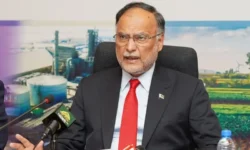CPEC Phase-II and Prime Minister Shehbaz Sharif’s Visit to China

05 June 2024
Published in: Pakistan Observer
Despite numerous speculations and western political hypes the Prime Minister of Pakistan Shehbaz Sharif’s visit to China has removed all notions of so-called widening gap between the two ironclad brothers – Pakistan and China. Hopefully, the ongoing visit would be a value addition in terms of bilateral diplomatic relations, trade, investments and better political understanding. Thus definitely the CPEC Phase-II will be revived as soon as possible creating a new platform for greater socio-economic prosperity and industrialization in the country.
The emerging geopolitical scenario in the region and around the globe has implanted immense pressure on the government not to put all eggs in one basket. Even the message of the international establishment remained very strong indicating stay away from China and the CPEC project put the government and its main stakeholders in a very difficult situation. However, the national leadership took a bold step and planned a visit to Beijing to overcome this political and diplomatic pressure which is a good omen. But conflicting issues about safety and security of the Chinese nationals and the CPEC projects would not be easily resolved. Hopefully sanity would prevail and both sides would agree to have a mutually agreed model of security to move forward in this regard.
The recent visit of the Deputy Prime Minister Ishaq Dar to Beijing, broke the ice and subsequently pledges were made by both sides to put the massive mega project of the CPEC and investment plan back on track after it has languished in recent years because of project delays, financial problems and a spate of deadly terrorist attacks on Chinese nationals working on the projects. Moreover, earlier in Beijing, Chinese Foreign Minister Wang Yi at his joint press conference with Dar had said: “The two sides agreed to strengthen the docking of development strategies and build an upgraded version of CPEC.”
According to a statement from the Ministry of Foreign Affairs the Prime Minister Shehbaz Sharif will be holding meetings with the Chinese President Xi Jinping and
Premier Li Qiang on topics such as upgrading the CPEC, advancing trade and investment and enhancing cooperation in security and defence, energy, space, science and technology and education. He will also meet executives of Chinese companies in the fields of oil and gas, energy, information and communications technology and emerging technologies.
Obviously, reinvigorating the CPEC is crucial to Pakistan’s struggling economy, which is beset by high inflation rates, trade deficits and massive debt, with the problems exacerbated by the Covid-19 pandemic, Russia-Ukraine war, catastrophic floods and political instability in the country. So Chinese connection, connectivity, cooperation and coordination is the way forward to defuse the invisible pressures and political manoeuvrings of the western forces because it would provide economic stability and sustainability in the country.
Critical analysis reveals out of the nine approved special economic zones, four are still under construction and five yet to be launched. As for transport infrastructure, only six projects have been completed, five are under construction and 13 have not yet been started. Nevertheless, about a dozen coal-fired power plants have been installed in addition to over half a dozen motorways and mass transit projects under the first phase. More road projects and a railway lines are planned in the CPEC Phase-II which must be initiated as soon as possible.
It seems that the CPEC faces economic, security and political challenges, China views it as a strategically pivotal project that strengthens its economic, political and security interests in the region and beyond and moreover there are many long-term interests attached with the project. It can facilitate the Chinese companies to reach the Middle Eastern and African markets in cost-effective ways and it can also be a counterbalance to India by strengthening China’s ties with Pakistan as a key strategic ally in the region.
The ongoing severe power struggle in the South China Sea and 10 years agreement of
Chabahar Port to India would definitely open a window of opportunity for both sides to further develop Gwadar Seaport and other mega projects of trans-regional connectivity under the flagship project of CPEC Phase-II.
It appears that the current visit of the Prime Minister Shehbaz Sharif to China would further strengthen bilateral relations in diverse sectors of economy, investment, joint ventures, industrialization, modernization, green transformation, building of special economic zones, connectivity, infrastructure development, social, culture, health, railways and notably artificial intelligence technologies in the days to come. Thus it would become a milestone in the development of China-Pakistan relations.
Hopefully while meeting with the Chinese President Xi Jinping, Premier Li Qiang and Chairman of the Standing Committee of the National People’s Congress Zhao Leji
Prime Minister Sharif would further foster spirits of mutual interest and jointly draw up a blueprint for the growth of bilateral relations. It would take new steps in building an even closer China-Pakistan community with a shared future in the new era. Additionally, meaningful talks on the cooperation in industry, agriculture, mining, new energy, information technology and other fields based on mutually befitting propositions creating a win-win situation would also be discussed promoting trade liberalization between two countries.
It is estimated that this visit would inject new impetus into China-Pakistan cooperation with China’s new development and promote the in-depth integration of “5Cs” i.e. growth corridor, livelihood-enhancing corridor, innovation corridor, green corridor and open corridor). So this visit would form a new framework, to create an upgraded version of the CPEC and build a closer China-Pakistan community with a shared future in the new era.
In summary, hopefully this visit of the Premier Sharif to China would create bridges of mutual trust, consultations, cooperation and consensus about various issues mainly safety, security of the Chinese nationals working on the projects of CPEC in the country. It would resolve pending issues of deferred payments of the Chinese private companies, restructuring of loans and inclusion of two hydropower projects under the flagship projects of CPEC Phase-II.
There are ongoing concerns about external debt sustainability, transparency, security and geopolitical tensions that Pakistan should immediately resolve to capitalise fully on the potential of the CPEC Phase-II. The role of SIFC would be important and decisive for the operationalization and channelization of the CPEC Phase-II in the country creating an investment and business friendly environment for attracting more and more inflows of the FDIs. The wild wings of the untamed bureaucracy must be tamped for the acceleration of the CPEC projects in the country.
Inclusion of hydrogen power generation, lithium battery, metals & amp; mining, hybrid rice, wheat and other cashable commodities, solar panels, artificial intelligence projects and last but not the least, science & amp; space is the need of the hour.





